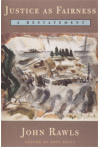- Author(s): John Rawls
- Edition: 1 Ed 2022
- ISBN 13 9780674279117
- Approx. Pages 214 + Contents
- Delivery Time 3-5 working days (within Kerala & South India) (Others 7-9 days)
- Shipping Charge Extra (see Shopping Cart)
............................................................................................
Description
In this work I have two aims. One is to rectify the more serious faults in A Theory of Justice that have obscured the main ideas of justice as fairness, as I called the conception of justice presented in that book. Since I still have confidence in those ideas and think the more important difficulties can be met, I have undertaken this reformulation. I try to improve the exposition, to correct a number of mistakes, to include some useful revisions, and to indicate replies to a few of the more common objections. I also recast the argument at many points. The other aim is to connect into one unified statement the conception of justice presented in Theory and the main ideas found in my essays beginning with 1974. Theory itself was nearly six hundred pages and the more relevant essays (of which there are about ten) bring the total close to a thousand pages. Moreover, the essays are not fully compatible, and ambiguities ory of Justice (1971, in stating various ideas make it difficult to find a clear and consistent view. The interested reader is entitled to assistance in seeing how these essays and Theory might fit to tance I try to provide by presenting in one place an account of justice a gether, where the revisions go and what difference they make. This assis fairness as I now see it, drawing on all those works. I have tried to make this as reformulation more or less self-contained. For those who have, some acquaintance with Theory, the main changes are of three kinds: first, changes in the formulation and content of the two principles of justice used in justice as fairness; second, changes in how the argument for those principles from the original position is organized; and as a political conception of justice rather than as part of a comprehensive third, changes in how justice as fairness itself is to be understood: namely, moral doctrine. To explain: two examples of changes of the first kind are these: one is a quite different characterization of the equal basic liberties and their priority, a change required to meet the forceful criticisms raised by H. L. A. Hart (813); another is a revised account of primary goods which connects them with the political and normative conception of citizens as free and equal persons, so that these goods no longer appear (as many pointed out to me, including Joshua Cohen and Joshua Rabinowitz) to be specified solely on the basis of psychology and human needs (§17). I also try to meet objec
tions raised by Amartya Sen (§51).
.........................................................................................
Contents
Part 1 : Fundamental Ideas
Part 2 : Principles of Fustice
Part 3 : The Argument from the Original Position
Part 4 : Institutions of a Fust basic Structure
Part 5 : The Question of Stability
............................................................................................
Author Details
John Rawls
Edited by Erin Kelly

